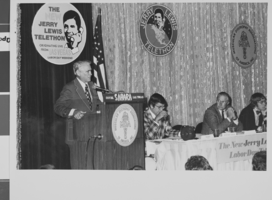Search the Special Collections and Archives Portal
Search Results
Valerie Pida Trust Records
Identifier
Abstract
The Valerie Pida Trust Records (1987-1993) are comprised of records documenting efforts by Edward "Ted" Quirk, an attorney and a board member of the University of Nevada, Las Vegas (UNLV) Foundation, to establish a trust for Valerie Pida, a UNLV student who had battled Hodgkin's lymphoma since the age of thirteen. Pida was a student at UNLV from 1985 to 1991 and was a cheerleader for the Runnin' Rebels basketball team. The records include correspondence, newspaper clippings, financial statements, and receipts that document the establishment and activities of the foundation, which operated until 1993.
Archival Collection
Lee Plotkin Papers
Identifier
Abstract
The Lee Plotkin papers document Plotkin's political work and associations as an LGBT activist and spokesman for the Las Vegas gay community, and include correspondence, press releases, copies of his columns, institutional and legislative documents, brochures, fliers and other ephemera from 1955 to 2006.
Archival Collection
UNLV Libraries Collection of Lady Luck Gaming Corporation Promotional Materials and Reports
Identifier
Abstract
The UNLV Libraries Collection of Lady Luck Gaming Corporation Promotional Materials and Reports includes annual reports, financial reports, press kits, press releases, and promotional materials for the Lady Luck Gaming Corporation in Nevada, Colorado, Iowa, Mississippi, and Missouri, dating from 1993-1995.
Archival Collection
Russ Freeman Television Music Manuscripts
Identifier
Abstract
The Russ Freeman Television Music Manuscripts contains music manuscripts and production materials from Russ Freeman's work on various television specials, dating from 1969 to 1977. The collection includes music scores for television soundtracks including
Archival Collection
Las Vegas Archive Memorabilia and Promotional Materials
Identifier
Abstract
The Las Vegas Archive Memorabilia and Promotional Materials (approximately 1960-2019) contains reproductions of photographs taken of historic landmarks around Las Vegas, Nevada and entertainers like Elvis Presley, Nat King Cole, Frank Sinatra, Dean Martin, and Liberace performing in Las Vegas. The collection also contains digital photographs from 2008 of an airship displaying an advertisement for the M Resort Spa and Casino. There is also memorabilia from the MGM Grand Hotel including a gaming guide, decks of playing cards, and a commemorative drinking glass. The collection also includes several historic postcards depicting Las Vegas, political campaign buttons for local Nevada elections, and greeting cards from U.S. Representative Jim Santini.
Archival Collection
Fayle Family Photographs
Identifier
Abstract
The Fayle Family Photographs depict the Fayle Family in Southern Nevada and California from 1888 to 1990. The photographs primarily include family photographs of Leonard Fayle, Anna Louise Trapnell Fayle, Leonard Fayle’s parents George Fayle and Jean Henderson Fayle, Leonard Fayle’s siblings George Arthur Fayle and Jean Nevada Fayle, and Leonard and Anna Fayle’s children Jane and Edward Fayle. The photographs also depict the Nevada towns of Las Vegas, Goodsprings, and Jean, including railroad operations, mining, milling, and hauling freight. The collection includes a leather-bound photograph album containing images of the Fayle Family and the Yount Family.
Archival Collection
Robert Scott Hooper Photographs [UNPROCESSED]
Identifier
Abstract
This collection is unprocessed; see the access note for additional information. The Robert Scott Hooper Photographs (approximately 1960-2019) consist of photographic negatives, positives, prints, Polaroids, 16mm films, videos, business records, correspondence, drawings, and ephemera. The collection was created by prolific photographer Robert Scott Hooper and his longtime business partner and wife, Theresa Holmes. The couple's life and business was based in Las Vegas, Nevada. Hooper's work focused on the female form, encompassing many areas of interest including sexual entertainment, modeling, pornography, and Las Vegas entertainment. Hooper was a contributing photographer with Playboy and Vegas Visitor magazines. Hooper also photographed many celebrities, Las Vegas production shows, notable events like hotel implosions, and the development of the Las Vegas Strip, including early time-lapse work on the Luxor Hotel and Casino and The Venetian. This collection also includes business records, model contracts, and correspondence.
Archival Collection
Fayle Family Papers
Identifier
Abstract
The Fayle Family Papers (1895-1998) document the family's personal and business interests in Goodsprings, Nevada and Las Vegas, Nevada. The collection contains mining documents, business records, and photographs from Leonard Fayle’s work with the Las Vegas Valley Water District, where he documented reservoirs, dams, and both abandoned and functioning mines. The photographs also include family members, vacations, and Southern Nevada fraternal organization pictures.
Archival Collection

Transcript of interview with Liliam Lujan Hickey by Claytee D. White, September 7, 2018
Date
Archival Collection
Description
Liliam Lujan Hickey was born in 1932 Havana, Cuba, where her father owned an insurance company and her mother was a music teacher. At age 17, Liliam married Enrique Lujan who owned five casinos and who was twelve years her senior. It was the early 1950s, and the people of Cuba lived with stark distinctions between upper class and low-income families. Liliam and Enrique lived a life of luxury. She became accustomed to flying to New York for dinner and wearing the finest Italian silks for custom dresses. Then in 1959, Liliam’s life took a vast turn as Fidel Castro rose to power and seized assets from the wealthy class. This upended Liliam’s family and in 1962, Liliam, Enrique and their three children fled to the United States. They first arrived in San Diego, California, where Liliam took a job at the Scripps Clinic. While Liliam spoke five different languages, she attended night school to learn English. Eventually, Liliam and her family moved to Las Vegas where Enrique could find work in the casinos. Unexpectedly in 1972, Enrique passed away, leaving Liliam and her children to fend for themselves. Liliam was thrust into the role of matriarch; she learned how to write a check and drive a car. She describes this as a period when her community activism awoke, how she secured a position working for the Nevada Welfare Administration Office, and how her persistent spirit led her to citizenship within a week. Through friends, Liliam met Nevada legislator Thomas Hickey, an Irish American who she endearingly nicknamed her Pink Husband. Liliam credits Senator Hickey with teaching her about life and the world, and ultimately inspiring much of her political activism. She was an active member of the Latin Chamber of Commerce, first known as el Circulo Cubano. At the peak of her career, Liliam became the first Latina to be elected to the Nevada State Board of Education. She envisioned building a village through schools in order to support and help all students be successful. A local Las Vegas school, Liliam Lujan Hickey Elementary School, was named in honor of her public service. Today, Liliam is retired, but continues to work to increase civic engagement in the Latinx community and improve our educational system.
Text

Photograph of Mayor Oran K, Gragson speaking at the pre-telethon production meeting, Las Vegas, Nevada, 1974
Date
Archival Collection
Description
Image
